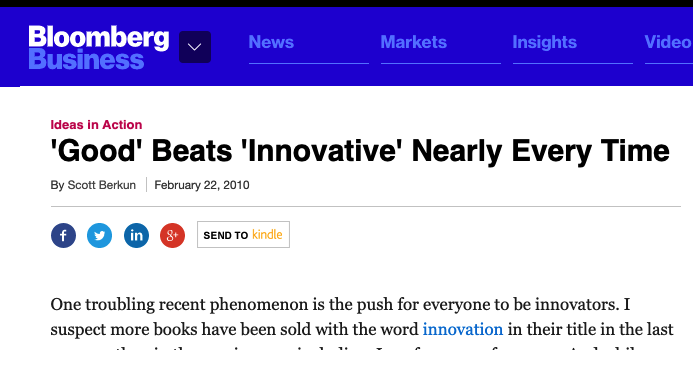Good Beats Innovative Nearly Every Time

[This post originally published on Bloomberg / BusinessWeek, February, 2010]
One troubling phenomenon is the push for everyone to be innovators. I suspect more books have been sold with the word innovation in their title in the last 10 years than in the previous 50, including, I confess, one of my own. And while much has changed, it’s hard to say the quality of things in the world has improved as fast. Keen-eyed consumers bemoan the low quality of many of the things we buy and try to use. Web sites divide short articles across 25 ad-filled pages. Gadgets quickly run out of power. Smartphones have anemic reception or fragile screens. Many things we buy and use never work in the way we’re promised, which suggests there are opportunities in merely being good: Much of what’s made falls short of that mark.
From my studies of the history of business innovation, I’m convinced you can beat competitors and even dominate markets without fancy tricks. All you need is the ability to make things that are good consistently, since few companies do.
While we’re fond of trumpeting the praises of Apple, whose iPod revolutionized music, we forget how dismal the competition was. It was not a field of masterpieces; it was a motley crew of ugly, clunky, painfully hard-to-use devices. Apple applied basic design sense to an immature field at a time when the world was ready for something better. Firefox, which rekindled innovation in Web browsing, arose from Microsoft‘s near abandonment of its Internet Explorer browser after the browser war with Netscape ended. Their version 6.0 release was a major step backward, opening the door for someone to win by merely providing something good, which Firefox did in 2004. Google was launched a decade after the invention of search engines; Amazon was not the first online bookstore. But they were both the first to do a good job at selling their good services for a good profit. In retrospect, their successes seem amazing, but at the time, the goals were simple and the objective humble and clear: Be good, or at least better than the other guys. For they knew that alone was hard enough.
Loose Usage
The word “innovation” is used to mean many different things, which is part of the problem. Executives and consultants throw it around like magic dust, hoping to cover their ignorance of why products and companies have done well or failed. But it’s clear most companies fail not because of their lack of inventiveness; it’s their lack of basic competence. Most leaders fail to prevent bureaucracy, hubris, and too many cooks from killing good ideas before they ever get a chance to make it out the door, resulting in the mediocrity we know too well.
Innovation, in the simplest definition, means new or novel, to take an approach others have not seen before. But by this definition, the iPod and Firefox barely qualify. Even the iPad is late in the game of tablet computers, as Microsoft’s Tablet PC and Amazon’s Kindle have been aiming at this market for years. In all cases, these are entrants into fields of established players. Their creators borrowed parts and ideas from other products and even from other companies. Their success or failure is driven less by revolutionary ideas or radical disruptive breakthrough thinking and more by a focus on making solid, reliable, simple, good products that solve real needs people have.
If your competitors are mediocre, the merely good can seem exceptional. All things being equal, in a battle between a good product and an innovative one, the good one will usually win. The makers of the good are less worried about abstract perceptions of how novel they are. Instead, they focus on results, caring less about whether the ideas involved are new, old, or recycled. Those obsessed with innovation contract the disease of hubris, ignoring many good ideas because they have been used before. They forget that an old idea cleverly reused, or borrowed from a different field, will be new to the world. Most projects aimed at innovation fail because creators become distracted by their egos from the true goal: to solve real problems for real people.
Solving a Problem
If you insist on doing something new, take this advice: Start with the important problems your customers, or your competitors’ customers, have and try to solve them. If conventional approaches fail, you’ll be forced to invent and be creative as a side effect of your goal. If you ask the creators of so-called breakthrough ideas, this is a common reason they found those breakthroughs in the first place. Their ambition wasn’t to be called an innovator. They weren’t planning to be disruptive or game changing. They merely had a tough problem to solve on their way to beating the competition in the forgotten practice of simply making better things.
Making better things is difficult enough. Learn to do that well, and when you’re done, and your customers and stockholders love you, the label “innovator” will magically land next to your name.

I agree entirely, so many people trying to make money out of new “innovative” things, that we probably don’t actually need, when what we do have isn’t even done properly. Well said.
Thought provoking article – and very insightful. Everyone is so focused on finding that once-in-a-lifetime breakthrough idea that we often overlook obvious improvements that can simply make something better than it was. Simple concepts like “know your customer” are too often overlooked – and if you don’t look after your customers, someone else surely will!